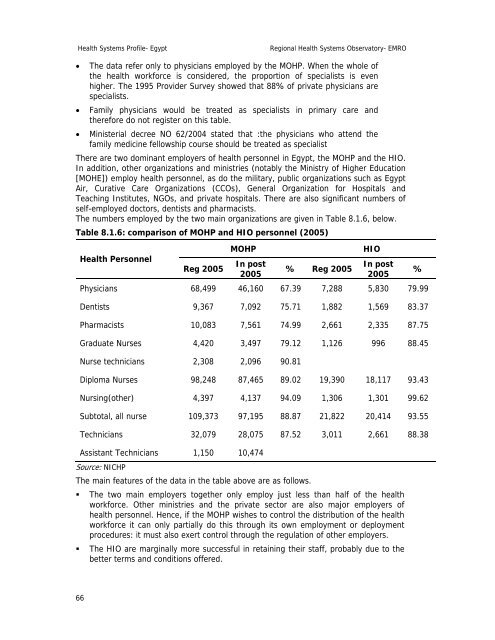Egypt : Complete Profile - What is GIS - World Health Organization
Egypt : Complete Profile - What is GIS - World Health Organization
Egypt : Complete Profile - What is GIS - World Health Organization
Create successful ePaper yourself
Turn your PDF publications into a flip-book with our unique Google optimized e-Paper software.
<strong>Health</strong> Systems <strong>Profile</strong>- <strong>Egypt</strong> Regional <strong>Health</strong> Systems Observatory- EMRO<br />
• The data refer only to physicians employed by the MOHP. When the whole of<br />
the health workforce <strong>is</strong> considered, the proportion of special<strong>is</strong>ts <strong>is</strong> even<br />
higher. The 1995 Provider Survey showed that 88% of private physicians are<br />
special<strong>is</strong>ts.<br />
• Family physicians would be treated as special<strong>is</strong>ts in primary care and<br />
therefore do not reg<strong>is</strong>ter on th<strong>is</strong> table.<br />
• Min<strong>is</strong>terial decree NO 62/2004 stated that :the physicians who attend the<br />
family medicine fellowship course should be treated as special<strong>is</strong>t<br />
There are two dominant employers of health personnel in <strong>Egypt</strong>, the MOHP and the HIO.<br />
In addition, other organizations and min<strong>is</strong>tries (notably the Min<strong>is</strong>try of Higher Education<br />
[MOHE]) employ health personnel, as do the military, public organizations such as <strong>Egypt</strong><br />
Air, Curative Care <strong>Organization</strong>s (CCOs), General <strong>Organization</strong> for Hospitals and<br />
Teaching Institutes, NGOs, and private hospitals. There are also significant numbers of<br />
self-employed doctors, dent<strong>is</strong>ts and pharmac<strong>is</strong>ts.<br />
The numbers employed by the two main organizations are given in Table 8.1.6, below.<br />
Table 8.1.6: compar<strong>is</strong>on of MOHP and HIO personnel (2005)<br />
<strong>Health</strong> Personnel<br />
66<br />
Reg 2005<br />
MOHP<br />
In post<br />
2005<br />
% Reg 2005<br />
HIO<br />
In post<br />
2005<br />
Physicians 68,499 46,160 67.39 7,288 5,830 79.99<br />
Dent<strong>is</strong>ts 9,367 7,092 75.71 1,882 1,569 83.37<br />
Pharmac<strong>is</strong>ts 10,083 7,561 74.99 2,661 2,335 87.75<br />
Graduate Nurses 4,420 3,497 79.12 1,126 996 88.45<br />
Nurse technicians 2,308 2,096 90.81<br />
Diploma Nurses 98,248 87,465 89.02 19,390 18,117 93.43<br />
Nursing(other) 4,397 4,137 94.09 1,306 1,301 99.62<br />
Subtotal, all nurse<br />
Technicians<br />
109,373 97,195 88.87 21,822 20,414 93.55<br />
32,079 28,075 87.52 3,011 2,661 88.38<br />
Ass<strong>is</strong>tant Technicians<br />
Source: NICHP<br />
1,150 10,474<br />
The main features of the data in the table above are as follows.<br />
The two main employers together only employ just less than half of the health<br />
workforce. Other min<strong>is</strong>tries and the private sector are also major employers of<br />
health personnel. Hence, if the MOHP w<strong>is</strong>hes to control the d<strong>is</strong>tribution of the health<br />
workforce it can only partially do th<strong>is</strong> through its own employment or deployment<br />
procedures: it must also exert control through the regulation of other employers.<br />
The HIO are marginally more successful in retaining their staff, probably due to the<br />
better terms and conditions offered.<br />
%

















